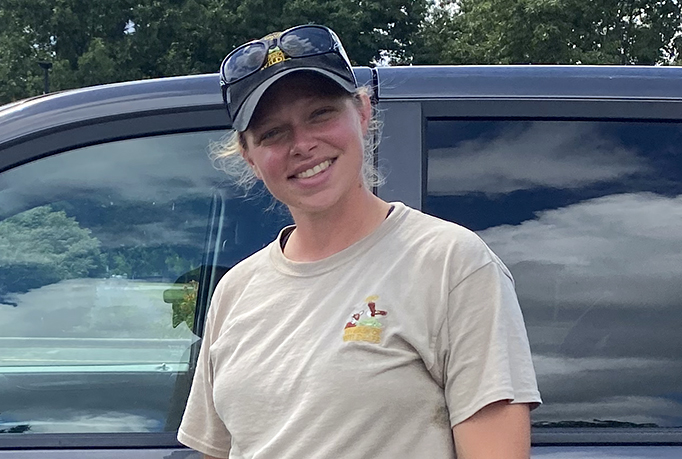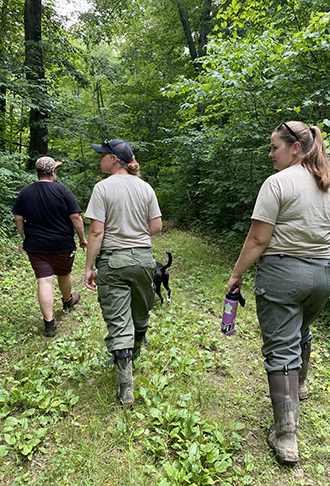
Aug. 7, 2021
Ohio wildlife professionals work day in and day out to help ensure healthy, thriving ecosystems for both animals and people. For the OWMA’s first manager spotlight, we caught up with Emilee Hardesty, a wildlife management consultant for the Ohio Department of Natural Resources Division of Wildlife. In her job, Hardesty works with landowners across central Ohio to help them establish, improve and maintain wildlife habitat. Read the interview below.
Could you give us some background about your education and career?
I attended a forestry and wildlife camp when I was a kid, and that’s what led me down this path. I ended up studying forestry and wildlife management at The Ohio State University, and during summers, I interned with ODNR. I jumped into the workforce from there — I’ve been with ODNR 11 years.
What does your role as a wildlife management consultant entail?
I talk to private landowners about improving their properties for wildlife, give management recommendations for invasive species and introduce federal cost-share programs that properties could be eligible for, like the Environmental Quality Incentives Program or Conservation Reserve Program. I work with a lot of community and school groups, too — I’m pretty much available free of charge to help anyone that wants habitat recommendations. When I’m not hiking properties, I also help with wildlife surveys, prescribed burns and bird banding. It’s an all-around job. Contact information for ODNR private land consultants>>
What’s a common mistake people make when trying to attract wildlife to their property?
Some people think doing nothing is great, but invasive species is one of our top concerns. When you just let your property do its thing, invasive species are often what jumps in, and you have to fight them down the road.

What’s your go-to advice for creating wildlife habitat?
Ideally, you want your property to have everything wildlife needs — food, water, shelter and a safe space to raise young — but sometimes that’s not feasible. In those cases, people can still benefit wildlife just by removing invasive species or planting native ones. Creating wildlife habitat is essentially just enhancing what you already have. Just looking out the window here, you’ve got a mowed yard, which could easily be a wildflower field or a tree planting. Even just letting the lawn grow taller would provide more cover.
What are the biggest challenges of your job?
Some of my counterparts in other parts of the state are working in 200-acre wetlands or forests, but a lot of the landowners I work with in central Ohio don’t have large tracts of land. It might be someone trying to make the most of their 1-acre plot. You realize how much of an impact you can make with so little space, and that’s rewarding.
Another enjoyable challenge is navigating talking to different people. The Division of Wildlife is here to help wildlife, but we’re also here to help people and help them coexist with wildlife. When I go to properties, I’m helping landowners understand situations from our perspective and the wildlife’s perspective. Not everybody has the same point of view, and that’s fine, as long as we’re educating. The more people we educate, the more people will implement our guidance, and the more wildlife species will benefit.
What’s your favorite Ohio wildlife species?
Probably the monarch butterfly or river otter. The monarch because a lot of what I’ve done with this job is help establish pollinator habitat, and just the biology of what happens in the cocoon is so fascinating. The last few summers, I’ve raised monarch caterpillars for my nieces, nephews and daughter, but the first year I did it for myself and was geeking out about it. Their migration is also amazing. Monarch butterflies overwinter in Mexico — they roost in forests in this certain air space, which sometimes get screwed up from extreme weather events. If they survive, they’ll start breeding and reproducing. The new generation heads north and maybe makes it to Texas, then those reproduce and die … it’ll be the fourth generation by the time they reach Ohio. It’s incredible how they figure out where to go, and they’ve done it for thousands of years.
The river otter is a great success story. I saw a river otter in the wild on my 23rd birthday, and it was so magical — they’re so playful, they mess and splash around just like kids would.
Any words of wisdom for aspiring wildlife professionals?
You can be broad with this field — you could have a biology degree — or you could narrow it down with a specific wildlife degree or criminal justice degree if you wanted to go the wildlife officer route. There are many different agencies you could work for that have similar missions in mind. If looking at college courses, I’d recommend public speaking, writing and any field classes — whether it’s identifying trees, plants, wildlife, birds. Once you learn the basics, then you can dive deeper into habitats and ecosystems.
What are your hopes for the future of wildlife in Ohio?
We’ve learned a lot over the last 150 years, and we’re continually putting that to work — improving habitats and trying to make Ohio the most suited for wildlife species and species diversity as possible. We’ve got bobcats and black bears moving through, and those are species that were once extirpated from Ohio. They’re coming back because habitat has improved, and now we need educate our humans, too, about human-wildlife conflict. Overall, I hope we continue what we’re doing. I’ll be curious to see what it’s like in 50 years.